The Clydesdale is among America’s tallest horse breeds.
For close to three centuries, Clydesdale’s popularity has grown.
The breed’s popularity is rooted in its formidable strength and endurance. This tall and heavy breed performed many tasks, including plowing fields and pulling wagons.
There is much more to learn about the Clydesdale horse breed. Explore their history, characteristics, and disciplines in this post.
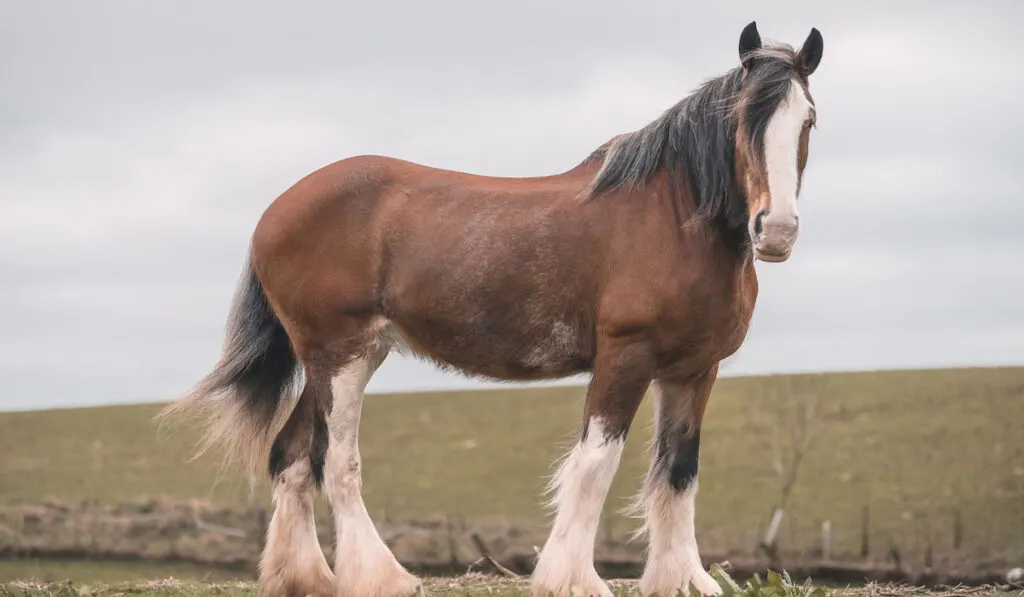
Table of Contents
The History of the American Clydesdale Horse
Origin of the Clydesdale Horse
The Clydesdale horse’s origin dates to the mid-18th century. In an effort to upgrade the indigenous horses of Lanarkshire in Scotland, this breed emerged.
The farmers wanted heavy-bodied horses that could perform agricultural duties. They could help in plowing fields and pulling wagons.
John Paterson of Lochlyoch and the 6th Duke Hamilton produced the Clydesdale. Both breeders lived in the Clyde Valley imported Flemish stallions and bred them with local draught mares, and the result was the Clydesdale breed.
Because of its strength and endurance in adverse weather conditions, the breed gained popularity fast.
The Clydesdale Horse Society recorded the largest number of entries in the late 19th century. That was also when exporting from Scotland to other countries was at its highest because of the breed’s popularity.
The first World War had a devastating effect on the breed’s numbers in Europe and the adoption of mechanized agriculture diminished their demand.
Today, the Clydesdale numbers are greatest in the United States, with around 600 new horses registered annually. Even so, the Rare Breeds Survival Trust listed the Clydesdale as “vulnerable” in 1975. Encouraged breeding programs have lessened its status to “at risk” presently.
Clydesdale Horse Society
The Clydesdales Horse Society (CHS) was formally launched in June 1877. It was established in Scotland and is one of the oldest breed societies in the world.
CHS is dedicated to the promotion, preservation, and advancement of the Clydesdale breed of horses.
The society also maintains a stud book and registry to ensure the breed’s bloodline protection.
It adheres to strict breeding standards to maintain the Clydesdales’ distinctive characteristics.
CHS also organizes events and competitions to showcase the breed’s versatility and encourage its use in various fields.
Foundation Sires
The Clydesdale horse breed has its roots in Scotland and owes its origin to two stallions; Glancer I and Farmer’s Fancy.
Glancer I’s sire, also known as Thompson’s Black Horse, was a black stallion foaled from some of the early crosses in the Clyde valley in the early 1800s. A daughter of his produced both Glancer I and Farmer’s Fancy.
These two stallions were instrumental in establishing this breed. When the stallions crossed with the local Scottish breeds, the Clydesdale emerged.
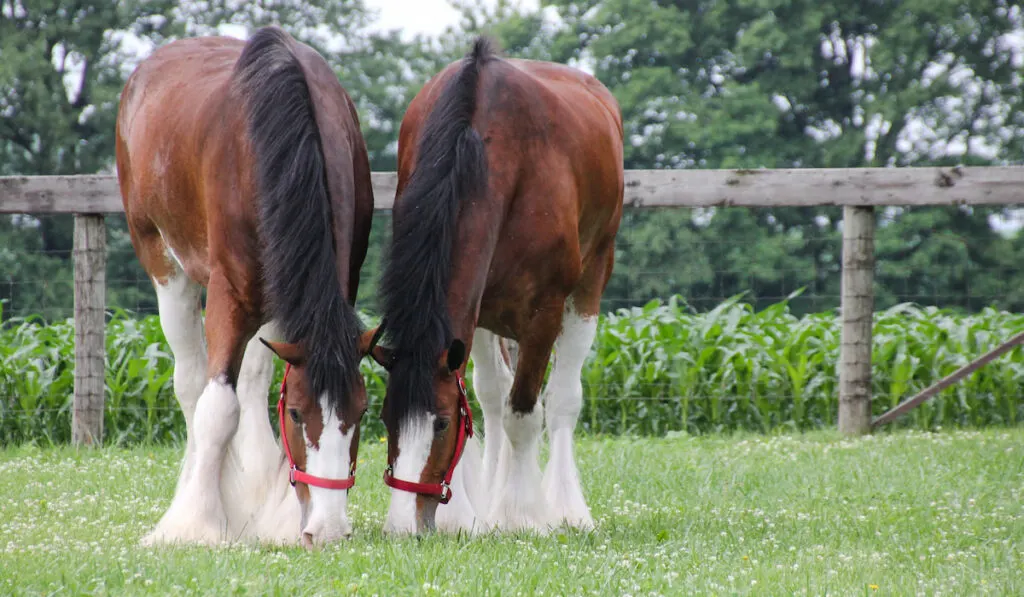
Characteristics
Conformation
The Clydesdale breed’s major task was farmwork.
Therefore, it is tall and heavy, with a convex facial profile. This means the ridge of the nose bows outward rather than sloping inwards.
It has a wide space between the eyes, a broad muzzle, and a flat profile. In addition, it has bright eyes, a long well-curved neck, and big ears.
The breed is 17-18 hands in height with a strong back and great rib depth.
However, these desirable characteristics have changed over the years. The new breeds can be 16 hands and much lighter.
Height
In the 1940s, the Clydesdale experienced an increase in size as their popularity in parades and shows increased.
This enticed the breeders to breed them to taller and more athletic bodies.
Modern Clydesdale adult males average between 17 to 19 hands, and adult females measure between 16 and 18 hands.
They are among the tallest horse breeds, second only to their British neighbors, the Shires, which are known for being even taller.
Weight
Despite their tall stature compared to other draft horse breeds, Clydesdales tend to have a lean and athletic body type. This makes them weigh less.
On average, adult males weigh between 1,700 to 2,200 pounds, while females typically weigh between 1,500 to 2,000 pounds.
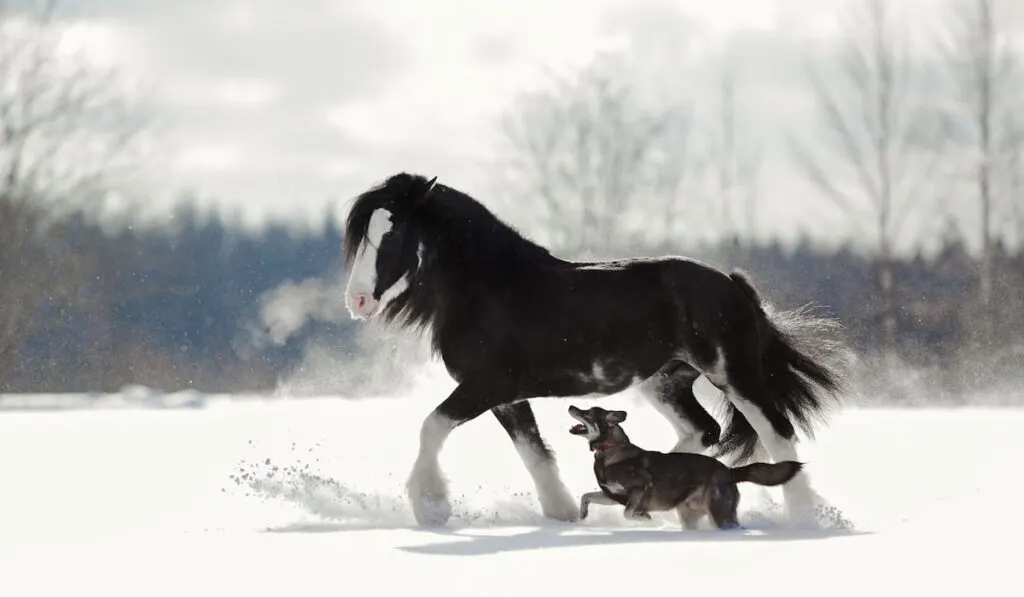
Colors
Clydesdales are most commonly found in bay (a rich mahogany brown) and brown colors. But they can also appear in gray, black, or roan (bay with some white hair).
It is typical for horses of this breed to have white markings on their face, legs, and occasionally on their body.
Temperament
Clydesdales, along with other draft horses, are often referred to as cold-blooded horses.
The typical temperament of a Clydesdale horse is calm, friendly, intelligent, and gentle when interacting with people.
They also have a low likelihood of being easily frightened or spooked.
Lifespan
Clydesdale horses live 20-25 years on average.
Although heart and/or kidney failure is a common cause of death in aged Clydesdales, some have been known to live into their 30s with appropriate nutrition and care.
Disciplines
Agriculture
Their size, strength, and endurance make them ideal for farm work.
In particular, people often used Clydesdales to pull plows in fields, as they could easily navigate through tough terrain and pull heavy equipment through the soil.
While Clydesdale horses are no longer primarily used in agriculture, they are still utilized for tasks such as plowing and hauling.
Logging
Clydesdale horses have been a valuable asset in the logging industry. Thanks to their impressive strength and adaptability to new environments.
They were frequently used to haul heavy logs out of the forest and were also employed to transport loggers and their equipment to and from the logging site.
Because of their size and strength, these horses could navigate through rough terrain and perform physically demanding tasks required in logging.
Carriage Services
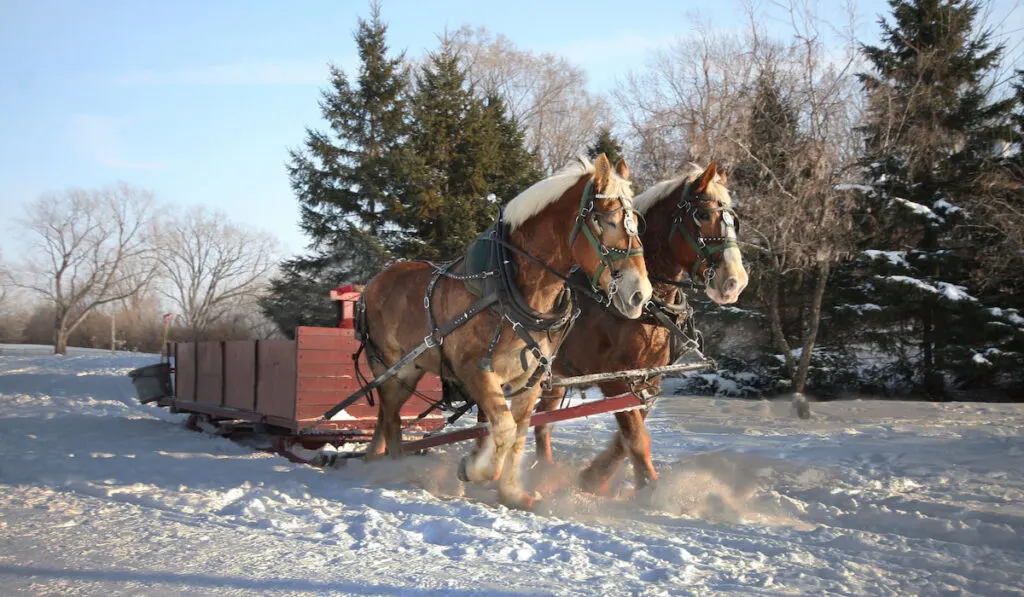
Their impressive strength makes them suitable for serving as carriage horses. This remains a popular use for them to this day.
Clydesdales have a primary role in the transportation of carriages during funerals, weddings, and royal events. They were also used to transport goods to and from the local markets.
Horse Parades
People commonly use Clydesdales in parades, pulling decorated wagons or carriages to showcase their strength and grace.
Handlers dressed in traditional equestrian attire may also ride them.
Clydesdales also perform as drum horses in parades. They carry two drums weighing about 110-120 pounds plus an officer. To do this, they need to be at least 17 hands high.
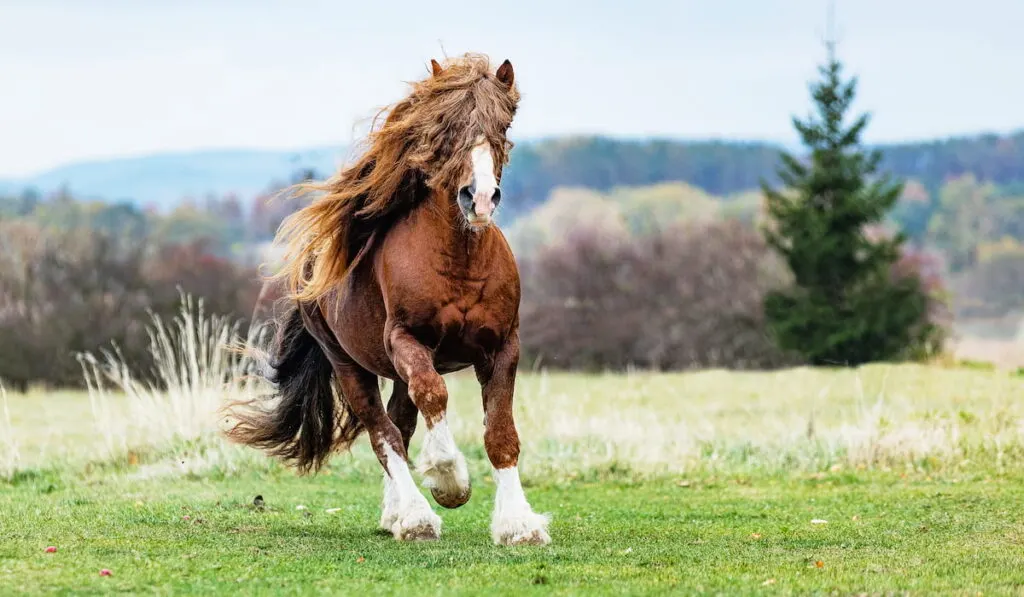
Clydesdale vs. Percheron
Despite being separate breeds, Clydesdales and Percherons are frequently confused with each other. Both horses are European exports with a draft horse lineage.
They are both known for their cold-blooded temperament. They exhibit a calm and intelligent nature when working with humans.
They both played a vital role in laying the foundation for cities during the Industrial Revolution.
The table below will help you tell these two equines apart as you compare and contrast.
| Clydesdale | Percheron | |
| Height | 17-19 hands | 16 -19 hands |
| Weight | 1800-2000 pounds | 1800-2600 pounds |
| Country of Origin | Scotland | France |
| Bloodline | Mostly pure | Out-crossed with Andalusians and Thoroughbreds |
| Colors | Gray, black, bay, chestnut | Bay, black, gray, chestnut, roan, sorrel |
Clydesdales are recognizable for their thick, feathered hair around the lower half of their legs.
Percherons, on the other hand, have a smooth coat with slightly thicker hair on their lower legs.
However, Percherons do not possess the same distinct feathering around their feet as seen in Clydesdales.
As a result of the initial crossbreeding, the Percheron breed is better suited for further crossbreeding today than Clydesdales.
Therefore, you can breed Percherons with Arabians, Thoroughbreds, and other draft horse bloodlines that are considered warm-blooded horses. This further enhances their special qualities.
On the other hand, it is better to breed Clydesdales with their own kind.
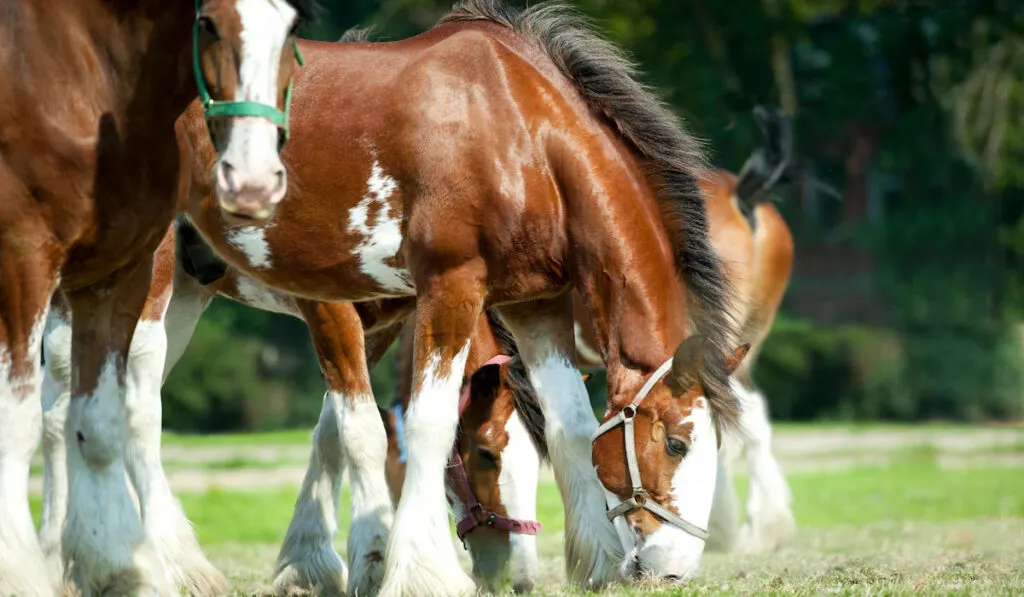
Health Issues
Clydesdale horses are not prone to diseases. However, they can suffer the following diseases especially when you expose them to unhygienic conditions and scorching sun.
- Clydes-itch. This condition affects the lower legs, which have a thick fur layer. The lower legs are difficult to clean and may harbor microscopic mites (mange) which cause itching.
- Chronic progressive lymphedema. The build-up of lymph fluid causes this condition on the lower legs which leads to swelling.
- Sunburn. They are prone to sunburn on their face during hot sunny days.
Simple routine practices such as keeping the horses clean and regulating the loads they carry can help you keep the above issues at bay.
You can also apply equine sun cream to their face to protect them from the scorching sun.
Final Thoughts
Clydesdale horses are one of America’s tallest and strongest horse breeds, with a rich history dating back to the mid-18th century.
Bred for farm work, the breed is known for its formidable strength, endurance, calm temperament, and adaptability to different environments.
During WW1, Clydesdale horses were extensively used to transport guns and artillery, resulting in significant casualties and a declining population.
The rise of machinery in industry and agriculture and a decrease in demand for heavy horses have also impacted their numbers. They are currently categorized as “at risk” on the Rare Breeds Survival Trust’s list.
Despite their declining population, Clydesdale horses are still useful in different disciplines. They include agriculture, logging, carriage services, and horse parades.
While the breed’s desirable characteristics may have evolved over the years, Clydesdales hold a special place in the hearts of many horse enthusiasts.
Resources
- https://www.animalife.co.uk/horse-breeds/clydesdale-horse/
- https://clydesdalehorsesociety.com/
- https://www.thesprucepets.com/meet-the-clydesdale-1886108#toc-clydesdale-history-and-origins
- https://www.clydesusa.com/
- https://www.thesprucepets.com/meet-the-percheron-horse-1886125
- https://www.helpfulhorsehints.com/percheron-vs-clydesdale/

